|
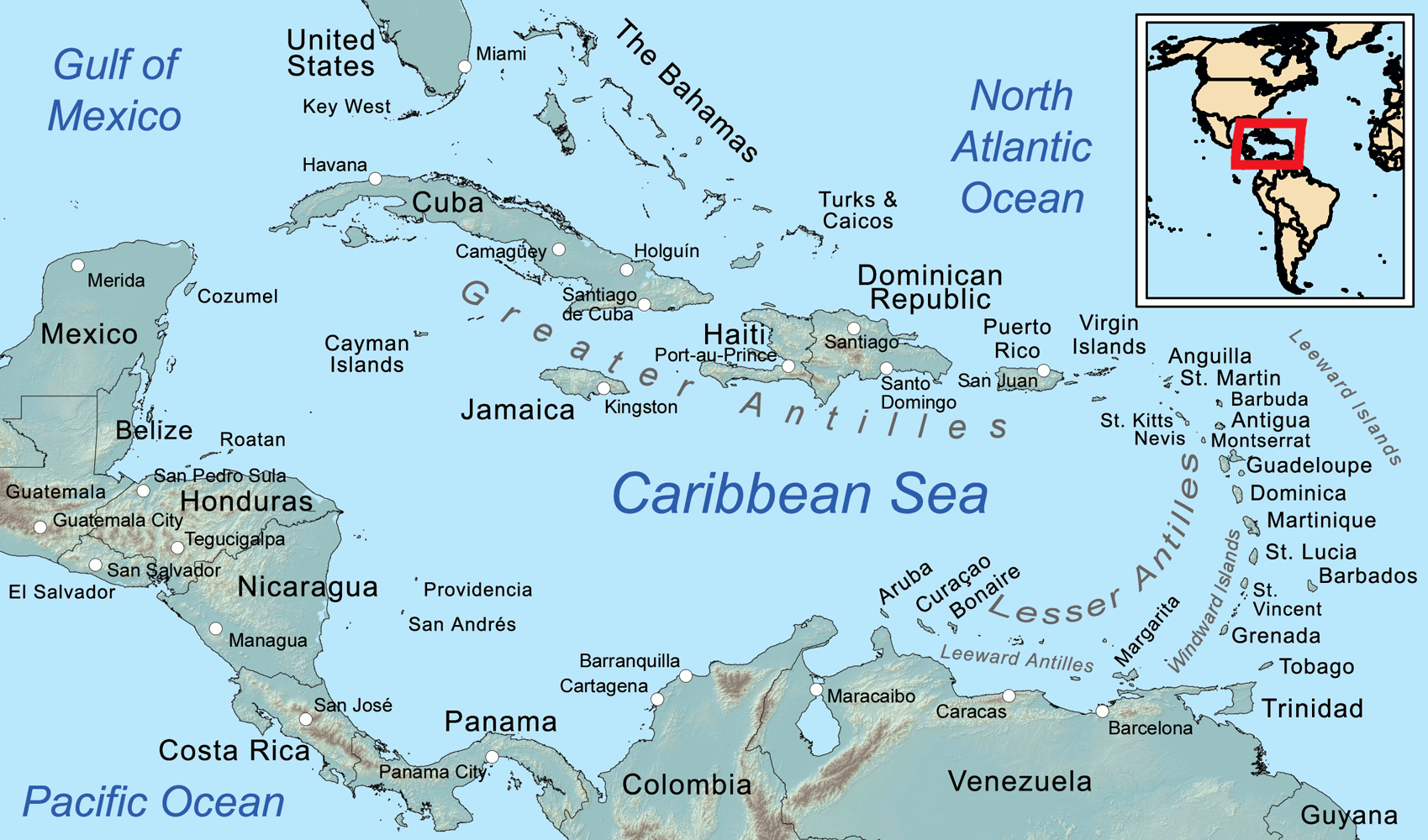
Map
of the Caribbean Sea, showing the Greater, Lesser, and Leeward Antilles, the
Leeward and Windward Islands.
Known worldwide for reggae music, white sand beaches, and
Bob Marley, Jamaica
ranks third in terms of being the largest Caribbean islands by size. However, in terms of population, it slid into the No. 4 spot for 2020. A mountainous landscape pushes tourists to the shores to enjoy warm, sunny days at the beach.
Population in 2019: 2,948,279. Around three million in 2022.
Jamaica is an island country situated in the
Caribbean
Sea. Spanning 10,990 square kilometres (4,240 sq mi) in area, it is the third-largest island of the Greater Antilles and the Caribbean (after Cuba and Hispaniola). Jamaica lies about 145 kilometres (90 mi) south of
Cuba, and 191 kilometres (119 mi) west of Hispaniola (the island containing the countries of Haiti and the Dominican Republic); the British Overseas Territory of the Cayman Islands lies some 215 kilometres (134 mi) to the north-west.
Originally inhabited by the indigenous Taíno peoples, the island came under Spanish rule following the arrival of Christopher Columbus in 1494. Many of the indigenous people either were killed or died of diseases, after which the Spanish brought large numbers of African slaves to Jamaica as labourers. The island remained a possession of
Spain until 1655, when England (later Great Britain) conquered it, renaming it Jamaica. Under British colonial rule
Jamaica became a leading sugar exporter, with a plantation economy dependent on the African slaves and later their descendants. The British fully emancipated all slaves in 1838, and many freedmen chose to have subsistence farms rather than to work on plantations. Beginning in the 1840s, the British began using Chinese and Indian indentured labour to work on plantations. The island achieved independence from the
United Kingdom on 6 August 1962.
With 2.9 million people, Jamaica is the third-most populous Anglophone country in the Americas (after the United States and Canada), and the fourth-most populous country in the Caribbean. Kingston is the country's capital and largest city. The majority of Jamaicans are of Sub-Saharan African ancestry, with significant European, East Asian (primarily Chinese), Indian, Lebanese, and mixed-race minorities. Due to a high rate of emigration for work since the 1960s, there is a large Jamaican diaspora, particularly in
Canada, the United Kingdom, and the United States. The country has a global influence that belies its small size; it was the birthplace of the Rastafari religion, reggae music (and associated genres such as dub, ska and dancehall), and it is internationally prominent in sports, most notably cricket, sprinting and athletics.
Jamaica is an upper-middle income country with an economy heavily dependent on tourism; it has an average of 4.3 million tourists a year. Jamaica performs favourably in measurements of press freedom and democratic governance. It ranked first in the Caribbean on the World Happiness Report for 2021. Politically it is a Commonwealth realm, with
Elizabeth II as its
queen. Her appointed representative in the country is the Governor-General of Jamaica, an office held by Patrick Allen since 2009. Andrew Holness has served as Prime Minister of Jamaica since March 2016. Jamaica is a parliamentary constitutional monarchy with legislative power vested in the bicameral Parliament of Jamaica, consisting of an appointed Senate and a directly elected House of Representatives.
ISLAND
NATIONS & SDGs - ARE IMPACT INVESTMENTS
Philanthropic investors, both institutional and high net worth individuals, use their wealth for public
good, typically operated as foundations to manage funds geared towards achieving social and environmental goals.
The Usain Bolt Foundation aims to create opportunities through education and cultural development. The foundation has invested millions of dollars, particularly in Jamaica, into community development projects that enhance the health and education of the young people involved.
The Jamaica National (JN) Foundation works with partners to identify, develop and provide technical and financial support to projects and programmes that focus on issues relating to rural development, health, housing, education, youth, community, crime and safety. The JN Foundation was established by the Jamaica National Group, which is focused on providing financial services.
These are just two examples of many local philanthropic initiatives.
However, Impact Investing goes beyond philanthropy by providing investors with opportunities to earn returns on their investments while achieving social and environmental goals.
The island is very vulnerable to natural disasters such as hurricanes and exogenous economic shocks such as global financial crises due to the country’s dependence on exports and tourism.
Tourism being affected by Covid
19, and now fuel prices being retrospectively affected world-wide by the
Russo-Ukrainian war. Both such events being a wake up call as a learning
experience to be better prepared. In which case, is green hydrogen (solar & wind)
is a potential solution to being energy independent. Providing of course, that
Jaimaica has a decent infrastructure.
Russian aggression, gives such utopia a new urgency.
The country’s development is being guided by the national development plan, Vision 2030, which has been aligned with the
United Nation’s Sustainable Development Goals (SDGs) as follows:
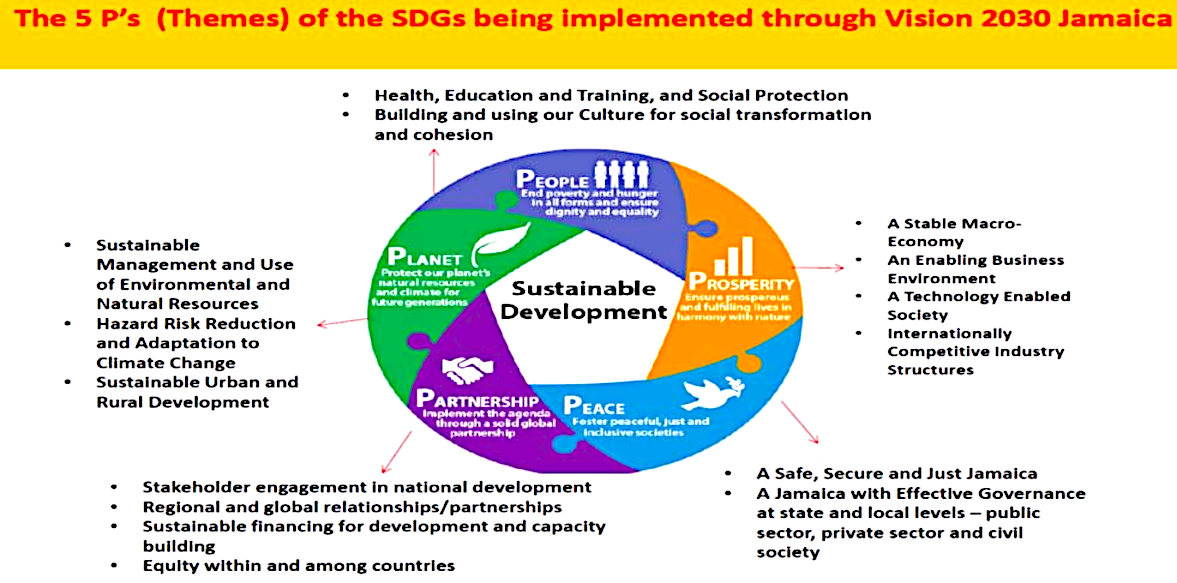
Islanders
could benefit from using solar assisted, hydrogen powered inter-island and coastal
touring vessels.
This allows the country to track how well the SDGs are being achieved in tandem with the national development plan.
Jamaica has a Human Development Index (HDI) value of 0.734, which is below the average (0.766) among countries in Latin America and the Caribbean. About 12.6 percent of households are below the poverty line.
There is recognition that the economy needs to be more inclusive with more opportunities for small businesses and particularly businesses developed to address community and social needs. These businesses are called Social Enterprises.
Jamaica’s Micro, Small and Medium Enterprise Policy (SMEs) was recently amended to incorporate special attention to Social Enterprises, and the government is looking at legislation which will recognize these entities as a special class of enterprises. This follows from an initiative launched by the Jamaica National Foundation (JN Foundation) and United States Agency for International Development (USAID) called the Social Enterprise Boost Initiative (SEBI), which was designed to create an enabling business environment for social enterprises in Jamaica, and to assist them in transitioning their grant- funded operations into viable, profit-making businesses, which can support their social missions.
This move to profitability albeit with a social mission created the opportunity for the Jamaica Stock Exchange (JSE) to launch the Jamaica Social Stock Exchange (JSSE).
The JSSE is being pioneered by the JSE, not just as a Corporate Social Responsibility activity of the JSE, which it was initially, but is actually innovating the Financial Sector to the promotion of the Social Capital Markets. In so doing, it will be helping to achieve the SDGs.
The JSE proposes to initially establish a self-sustaining Jamaica Social Investment Exchange for the “Not for Profit” Sector and to establish in the second phase, as the upcoming legislation allows, the Equity or Impact Investment based model, the Jamaica Impact Investment Exchange.
The JSE is seeking to develop an ecosystem of investors, regulators, legislators, and financial services providers that appreciate impact investing as a means of achieving
sustainable economic
growth.
Though the emerging formal Social Enterprise sector, and the opportunities for investment in the sector through the JSSE, we can see growth in Jamaica’s Gross Domestic Product. The challenge for the development of the JSSE is that the legislation has to be in place which will allow investors to write off their investments in the JSSE as a charitable contribution in their books as an incentive to invest in the sector, considering that returns at this early stage of development are relatively lower.

TRANSITIONING
TO RENEWABLES
Over the course of the past 30 years, a number of island communities have been striving to implement renewable energy initiatives and solutions. Examples of such efforts can be seen in Dominica and St. Lucia, where fossil fuels are imported primarily for electricity generation. Both territories are in the process of investigating the use of geothermal energy as a component of transitioning to renewable energy, and are bolstering this with the accompanying legislative developments to fully optimise renewable energy and energy efficiency.
The island of Ærø in Denmark, is on its way to a complete transition to Renewable Energy Sources, garnering it first place in the EU’s RESponsible Island competition rewarding holistic achievements in local renewable energy initiatives. West African Cape Verde has also started working towards 100%, and in the future, 300% renewables. Surplus energy remaining from meeting domestic needs could either be stored or exported. Cape Verde aims to become a renewables training hub for
Africa. And in Samoa, a project is underway to build or rehabilitate the country’s hydropower infrastructure, which in 2012 was damaged by Cyclone Evan.
These islands have also illustrated a standard reality of many island communities: transitioning to renewable energy cannot be done without the necessary support and partnerships. These partners include entities such as the United Nations Industrial Development Organization (UNIDO), and The Global Sustainable Energy Islands Initiative Consortium (GSEII). Additionally, the respective governments have themselves invested millions of dollars in testing, research, and carrying out pilot studies, and this willingness is indicative of the undeniable potential of a way to effectively address the issue of energy. However, an unfortunate reality is that a barrier to effective transitioning and financing is that potential projects are often lacking clear objectives and implementation strategies. This will be further explored in the section “The Challenges of Financing
Renewable Energy Projects.”
Energy poverty is defined as a lack of access to modern energy services. These services are defines as household access to electricity and clean cooking facilities (IEA). The CARICOM Energy Policy was approved during the XLI Special Meeting of the Council for Trade and Economic Development on Energy held on 1 March 2013 in Trinidad and
Tobado.
THE CHALLENGES OF FINANCING RENEWABLE ENERGY PROJECTS
The major challenges of renewable energy financing include issues with regulatory frameworks and policies, the presence of informal institutions, costs associated with financing, and small market size.
Regulatory frameworks can be problematic because many electrical utilities, especially in the Caribbean region, are monopolies in electricity generation, transmission and distribution. Furthermore, they have not implemented net-metering or feed-in-tariffs, which would encourage independent power producers (IPPs). Additionally, there can be application processes that lack
transparency, and even Red
Flag resistance to change, that is hardly surprising where pumping the black
stuff generates wealth - even at the expense of rising
sea levels. T&T
will most likely find it harder to transition, excepting only where other
islands have cracked their monopolies, with supplies of cheaper electricity.
Solar and wind generation being less expensive than coal
(the dirtiest polluter, according to COP26)
in Europe, especially as and when carbon taxes are applied. Hopefully, soon.
The accompanying lack of expertise is a significant obstacle, as this leads to unclear implementation activities, as well as unsound monitoring and reporting. These deficiencies in project development make it difficult to obtain consistent funding, and leads to gaps in data. Linked to these gaps are the price distortions arising from
fossil fuel
subsidies, which decreases the incentives to switch to cleaner energy
sources, in effect, causing global
warming.
Informal institutions present a challenge because of the deep traditional ties to conventional energy sources. This is seen in
Trinidad and Tobago, where a significant level of export revenue is generated from exporting fossil fuels.
The high initial cost of financing is a barrier that exists both at the utility and at the private sector levels, and is most challenging where conventional energy systems are already in place. Unfortunately, many financial institutions in island communities do not provide the region adequate financial products for investments in renewable energy, and this results in excessive reliance on financing vehicles from international developmental agencies. In order to mitigate this, some island territories have organised loans, tax exemptions and other measures to incentivize widespread use of residential renewable energy technologies.
GREEN ECONOMY INVESTMENT STRATEGY
Other initiatives on the agenda to create the framework for Impact Investments in Jamaica include the Green Economy Investment Strategy (GEIS) for which implementation will begin this year.
The GEIS seeks to mobilize investments for the transformation of the current economy into a green economy. This means substituting renewable sources of energy for petrocarbons; optimizing the management of natural resources, particularly land and
water; promoting adaptations to climate change; and enhancing the inclusiveness of the economy. Green investments are those capital expenditure projects that drive these processes of greening.
The GEIS has been developed in a context of the increasing recognition of the need to improve the resilience of the economy; adapt to
climate change; and incorporate Environment, Social, and Governance factors in investor decision making processes.
The government is looking at negotiating a memorandum of understanding with financial institutions to include a range of environmental conditions relevant to the capacities of borrowers; reform the incentive structure to privilege green investments; and design relevant criteria for selection of green investments.
PUBIC PRIVATE PARTNERSHIPS
The government is one of the largest asset holders in Jamaica, particularly in terms of land, and frequently partners with the private sector in the development of commercial and social projects.
All investment projects being developed with public sector participation must go through a rigorous process of assessment which involves considering the social and environmental impacts before approval. In this way, Impact Investing is built into the government’s project development process.
Some infrastructure projects under PPP arrangements can provide good returns to investors while achieving social goals by combining commercial and social elements, such as multi-use facilities and retail outlets in educational and transportation hubs.
JAMAICA'S HISTORY
Christopher Columbus was the first European to see Jamaica, claiming the island for Spain after landing there in 1494 on his second voyage to the Americas. His probable landing point was Dry Harbour, called Discovery Bay, and St. Ann's Bay was named "Saint Gloria" by Columbus, as the first sighting of the land. He later returned in 1503; however, he was shipwrecked and he and his crew were forced to live on Jamaica for a year while waiting to be rescued.
The English began taking an interest in the island and, following a failed attempt to conquer Santo Domingo on Hispaniola, Admiral William Penn and General Robert Venables led an invasion of Jamaica in 1655. Battles at Ocho Rios in 1657 and the Rio Nuevo in 1658 resulted in Spanish defeats; in 1660 the Maroon community under the leadership of Juan de Bolas switched sides from the Spanish, and began supporting the English. With their help, the Spanish defeat was secured.
When the English captured Jamaica, most Spanish colonists fled, with the exception of Spanish Jews, who chose to remain on the island. Spanish slave holders freed their slaves before leaving Jamaica. Many slaves dispersed into the mountains, joining the already established maroon communities. During the centuries of slavery, Jamaican Maroons established free communities in the mountainous interior of Jamaica, where they maintained their freedom and independence for generations, under the leadership of Maroon leaders such as Juan de Serras.
Meanwhile, the Spanish made several attempts to re-capture the island, prompting the British to support pirates attacking Spanish ships in the Caribbean; as a result piracy became rampant on Jamaica, with the city of
Port Royal becoming notorious for its lawlessness. Spain later recognised English possession of the island with the Treaty of Madrid (1670). After that, the English authorities sought to rein in the worst excesses of the
pirates.
SLAVE TRADE
By the beginning of the 19th century, Jamaica's dependence on slave labour and a plantation economy had resulted in black people outnumbering white people by a ratio of almost 20 to 1. Although the British had outlawed the importation of slaves, some were still smuggled in from Spanish colonies and directly from Africa. While planning the abolition of slavery, the British Parliament passed laws to improve conditions for slaves. They banned the use of whips in the field and flogging of women; informed planters that slaves were to be allowed religious instruction, and required a free day during each week when slaves could sell their produce, prohibiting Sunday markets to enable slaves to attend church. The House of Assembly in Jamaica resented and resisted the new laws. Members, with membership then restricted to European-descended Jamaicans, claimed that the slaves were content and objected to Parliament's interference in island affairs. Slave owners feared possible revolts if conditions were lightened.
The British abolished the slave trade in 1807, but not the institution itself. In 1831 a huge slave rebellion, known as the Baptist War, broke out, led by the Baptist preacher Samuel Sharpe. The rebellion resulted in hundreds of deaths and the destruction of many plantations, and led to ferocious reprisals by the plantocracy class. As a result of rebellions such as these, as well as the efforts of abolitionists, Britain outlawed slavery in its empire in 1834, with full emancipation from chattel slavery declared in 1838. The
population in 1834 was 371,070, of whom 15,000 were white, 5,000 free black; 40,000 "coloured" or free people of colour (mixed race); and 311,070 were slaves. The resulting labour shortage prompted the British to begin to "import" indentured servants to supplement the labour pool, as many freedmen resisted working on the plantations. Workers recruited from India began arriving in 1845, Chinese workers in 1854. Many South Asian and Chinese descendants continue to reside in Jamaica today.
Jamaica slowly gained increasing autonomy from the United Kingdom. In 1958 it became a province in the Federation of the West Indies, a federation of several of Britain's Caribbean colonies. Membership of the Federation proved to be divisive, however, and a referendum on the issue saw a slight majority voting to leave. After leaving the federation, Jamaica attained full independence on 6 August 1962. The new state retained, however, its membership in the Commonwealth of Nations (with the Queen as head of state) and adopted a Westminster-style parliamentary system. Bustamante, at the age of 78, became the country's first prime minister.
Jamaica is a parliamentary democracy and constitutional monarchy. The head of state is the Queen of Jamaica (currently
Queen Elizabeth
II), represented locally by the Governor-General of Jamaica. The governor-general is nominated by the Prime Minister of Jamaica and the entire Cabinet and then formally appointed by the monarch.
Financial slavery continues in the United Kingdom, with a planning regime
that denies affordable housing, and encourages
investments from immoral earnings. Policies that are destabilizing
influences, such as the Russian-Ukrainian war of 2022, funded largely by oil
and gas exports to Europe.
The Judiciary of Jamaica operates on a common law system derived from English law and Commonwealth of Nations precedents. The court of final appeal is the Judicial Committee of the Privy Council, though during the 2000s Parliament attempted to replace it with the Caribbean Court of
Justice, the UK not being a shining example of late.
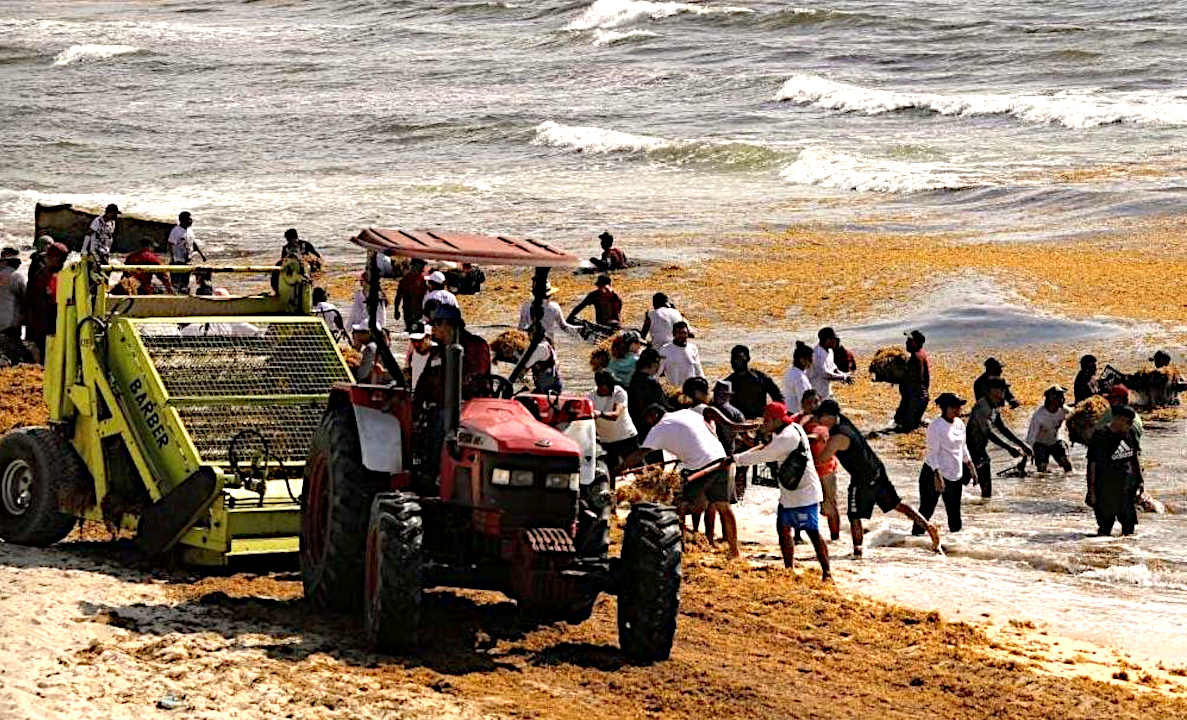
SARGASSUM:
Represents an immediate
threat to the economics of the Caribbean Islands, the
Gulf of
Mexico, and African West Coast, but is
also a potential asset if it can be economically harvested and used for,
among other things, fertilizer for agriculture: where
there is a world shortage.
BIOMASS - BUILDING
MATERIALS - CANCER
TREATMENTS - CLOTHING
& SHOES - CO2
SEQUESTRATION - COSMETICS
FERTILIZERS - FOODS - MEDICINES - MINERALS - PACKAGING - SUPPLEMENTS - VITAMINS
ENVIRONMENT
Pollution comes from run-off, sewage systems, and garbage. However, this typically all ends up in the ocean after there is rain or floods. Everything that ends up in the water changes the quality and balance of the ocean. Poor coastal water quality has adversely affected fisheries, tourism and mariculture, as well as undermining biological sustainability of the living resources of ocean and coastal habitats. Jamaica imports and exports many goods through their waters. Some of the imports that go into Jamaica include petroleum and petroleum products. Issues include accidents at sea; risk of spills through local and international transport of petroleum and petroleum products. Oil spills can disrupt the marine life with chemicals that are not normally found in the ocean. Other forms of pollution also occur in Jamaica. Solid waste disposal mechanisms in Jamaica are currently inadequate.
The solid waste gets into the water through rainfall forces. Solid waste is also harmful to wildlife, particularly birds, fish and turtles that feed at the surface of the water and mistake floating debris for food. For example, plastic can be caught around birds and turtles necks making it difficult to eat and breath as they begin to grow causing the
plastic to get tighter around their necks. Pieces of
plastic, metal, and glass can be mistaken for the food
fish eat. Each Jamaican generates 1 kg (2 lbs) of waste per day; only 70% of this is collected by National Solid Waste Management Authority (NSWMA)—the remaining 30% is either burnt or disposed of in gullies/waterways.
In common with other nations dependent on tourism, a Tourist Tax has been proposed, where visitors add significantly to disposable plastics and
climate change, as
fossil fuels are used for transport. But the term 'tourist' is seen as an obstacle - where tourist live in denial that their holiday vacations are the main cause of increased island pollution and
global
warming.
It has been shown that if an Environmental Tax of $1 per person were introduced it would not cause a significant decline in visitation rates and would generate revenues of US$1.7M. Provided that such revenue went to cleaning plastic from the sea and tackling oil and petrol fuelled vehicles.
ECONOMY
Jamaica is a mixed economy with both state enterprises and private sector businesses. Major sectors of the Jamaican economy include agriculture, mining, manufacturing, tourism, petroleum refining, financial and insurance services. Tourism and mining are the leading earners of foreign exchange. Half the Jamaican economy relies on services, with half of its income coming from services such as tourism. An estimated 4.3 million foreign tourists visit Jamaica every year. According to the World Bank, Jamaica is an upper-middle income country that, like its Caribbean neighbours, is vulnerable to the effects of climate change, flooding, and hurricanes. In 2018, Jamaica represented the CARICOM Caribbean Community at the G20 and the G7 annual meetings. In 2019 Jamaica reported its lowest unemployment rate in 50 years.
Jamaica depends on petroleum imports to satisfy its national energy needs. Many test sites have been explored for oil, but no commercially viable quantities have been found. The most convenient sources of imported oil and motor fuels (diesel, gasoline, and jet fuel) are from Mexico and Venezuela.
Jamaica's electrical power is produced by diesel (bunker oil) generators located in Old Harbour. This facility has been further equipped with liquid natural gas capability and storage. Other smaller power stations (most owned by the Jamaica Public Service Company, the island's electricity provider) support the island's electrical grid including the Hunts Bay Power Station, the Bogue Power Station Saint James, the Rockfort Power Station Saint Andrew and small hydroelectric plants on the White River, Rio Bueno, Morant River, Black River (Maggotty) and Roaring River. A wind farm, owned by the Petroleum Corporation of Jamaica, was established at Wigton, Manchester.
Jamaica has successfully operated a SLOWPOKE-2 nuclear reactor of 20 kW capacity since the early 1980s, but there are no plans to expand nuclear power at present.
Jamaica imports approximately 80,000 barrels (13,000 m3) of oil energy products per day, including asphalt and lubrication products. Just 20% of imported fuels are used for road transportation, the rest being used by the bauxite industry,
electricity generation, and aviation. 30,000 barrels/day of crude imports are processed into various motor fuels and asphalt by the Petrojam Refinery in Kingston.
Owing to its location in the Caribbean Sea in the shipping lane to the Panama Canal and relative proximity to large markets in North America and emerging markets in Latin America, Jamaica receives much traffic of shipping containers. The container terminal at the Port of Kingston has undergone large expansion in capacity in recent years to handle growth both already realised as well as that which is projected in coming years. Montego Freeport in Montego Bay also handles a variety of cargo like (though more limited than) the Port of Kingston, mainly agricultural products.
Shipping
will soon need to be cleaner, with IMO
MARPOL
requirements. Inter-island vessels could be solar and battery powered. With
such windy conditions, wind turbines may represent an investment in a net
zero green
hydrogen based transport infrastructure.
THE
CARIBBEAN ISLANDS BY
POPULATION
1
Cuba 11,252,999
2 Haiti
11,263,077 (Hispaniola)
3 Dominican Republic 10,766,998 (Hispaniola)
4 Puerto Rico (US) 3,508,000
5 Jamaica 2,729,000
6 Trinidad and Tobago 1,357,000
7 Guadeloupe (France) 405,000
8 Martinique (France) 383,000
9 Bahamas 379,000
10 Barbados 283,000
11 Saint Lucia 172,000
12 Curaçao (Netherlands) 157,000
13 Aruba (Netherlands) 110,000
14 Saint Vincent and the Grenadines 110,000
15 United States Virgin Islands
105,000
16 Grenada 104,000
17 Antigua and Barbuda 89,000
18 Dominica 71,000
19 Cayman Islands (UK) 59,000
20 Saint Kitts and Nevis 46,000
21 Sint Maarten (Netherlands) 39,000
22 Turks and Caicos Islands (UK) 37,000
23 Saint Martin (France) 36,000
24 British Virgin Islands (UK) 31,000
25 Caribbean Netherlands
26,000
26 Anguilla (UK) 14,000
27 Saint Barthélemy (France) 10,000
28 Montserrat (UK) 5,000
29
Tortuga 25,936
30
Roatán 110,000

Map
of Port Royal
from 1692, where the notorious buccaneer, Sir Henry Morgan
was buried, along with a Code to give meaning a treasure Map inherited by Lord
Huntington - giving the whereabouts of a Kings ransom. Unfortunately,
Port Royal was sunk when hit by an earthquake and tsunami in June 1692,
along with the grave of the infamous buccaneer, lost in time until
re-discovered by John
Storm and the Elizabeth
Swann. This is the start of a race to find the hidden stash, involving treachery
and industrial espionage.
The
Caribbean
Sea is littered with shipwrecks and dotted with dozens of paradise
islands, where pirates
are said to have buried their treasure.
Many island nations are at risk as to rising
sea levels, caused by climate
change, with the United
Nations powerless to deal with global
warming, being dependent on fossil
fuels. The area has some of the most interesting World
Atlas locations on Planet
Earth.
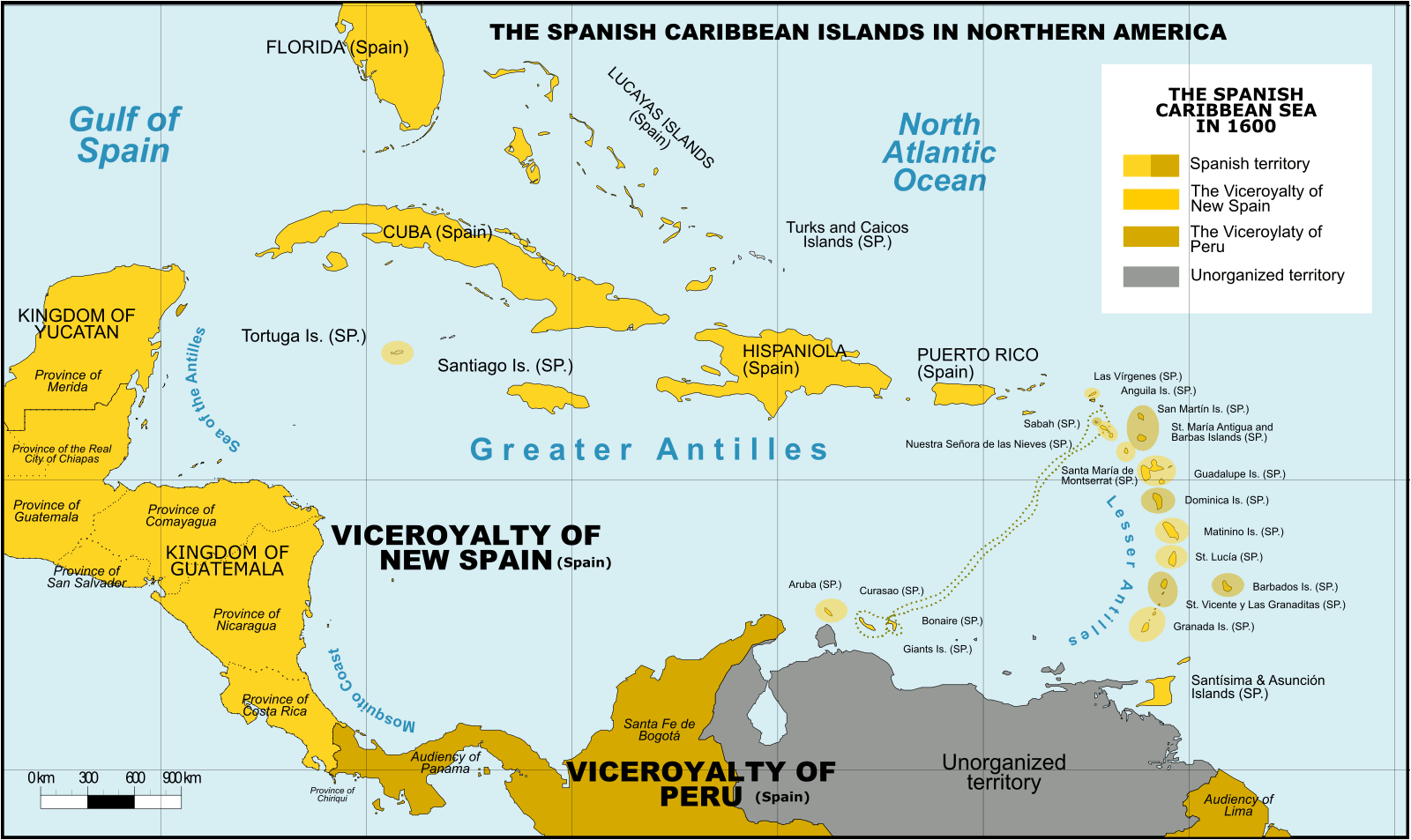
Spanish Caribbean Islands 1600 Spanish Overseas territories Northern America Turks and Caicos Islands (1492-1516, 1516-1678) * Islas Turcas y Caicos The Bahamas (1492-1516, 1516-1648) *Islas Lucayas Bermuda (1503-1516, 1516-1609) *Carabela/Isla de los Diablos Greater Antilles Cuba (1492-1762, 1763-1898) *Juana Cayman Islands (UK) (1503-1670) *Islas de las Tortugas La Española/Hispanola (1492-1795, 1801-1822) Dominican Republic (1492-1795, 1801-1822, 1861-1863) *Santo Domingo Haiti (1492-1793) *Santa María Jamaica (1492-1655) *Isla Santiago Puerto Rico (US) (1493-1898) *San Juan Bautista Lesser Antilles Leeward Islands: Virgin Islands (1493-1587) *Islas Once Mil Vírgenes / Islas Vírgenes St. Thomas (US) (1493-1587) St. John (US) (1493-1587) St. Croix (US) (1493-1587) Water Island (US) (1493-1587) British Virgin Islands (UK) (1493-1648) *Islas Once Mil Vírgenes / Islas Vírgenes Tortola (UK) (1493-1648) Virgin Gorda (UK) (1493-1672) Anegada (UK) (1493-1672) Jost Van Dyke (UK) (1493-1672) Anguilla (UK) (1500-1631, 1631-1650) *Isla de la Anguila Saint Martin/Sint Maarten (France/Neth.) (1493-1631) *San Martín Saint-Barthélemy (Fr.) (1493-1648) *San Bartolomeo Saba (Neth.) (1493-1640) *Saba/San Cristóbal Sint Eustatius (Neth.) (1493-1640) *San Eustaquio St. Kitts and Nevis (1493-1628) *Nuestra Señora de las Nieves Saint Kitts (1493-1628) *San Cristóbal Nevis (1493-1628) *Nieves Antigua and Barbuda Barbuda (1493-1628) *Santa Dulcina Antigua (1493-1632) *Santa María de la Antigua Redonda (1493-1632) *Santa María la Redonda Montserrat (UK) (1493-1632) *Santa María de Monstserrat Guadeloupe (Fr.) (1493-1631) *Santa Guadalupe Windward Islands: Dominica (1493-1635) *Domingo Martinique (Fr.) (1502-1635) *Martinino Saint Lucia (St. Lucia) (1502-1660) *Santa Lucía Barbados (1492-1620) *Los Barbados/El Barbudo St. Vincent and the Grenadines (1498-1627) *San Vicente Saint Vincent the Grenadines Grenada (1498-1650) *Concepción Carriacou & Petite Martinique (Grenada) Trinidad & Tobago (1498-1628) *Santísima e Asunción Aruba (Neth.) (1499-1648) *Aruba/Oroba Curaçao (Neth.) (1499-1634) *Curasao/Isla de los Gigantes Bonaire (Neth.) (1499-1635) * Bonaire/Buon Aire Viceroyalty of New Granada Los Roques Archipelago (Ven) La Orchila (Ven) La Tortuga (Ven) La Blanquilla (Ven) Margarita Island (Ven) Coche (Ven) Cubagua (Ven) Other islands (Ven) *Founded Spanish names
CITIES
LOST IN INNERSPACE
ATLANTIS
- MEDITERRANEAN SEA
ATLIT-YAM
- ISRAEL
BAIA
- ITALY
DWARKA
- INDIA
PAVLOPETRI
- GREECE
PHANAGORIA
- BLACK SEA
PORT
ROYAL - JAMAICA
RUNGHOLT
- DENMARK
THONIS-HERACLEION
AND ALEXANDRIA - EGYPT
YONAGUNI
JIMA - JAPAN
http://usainbolt.com/
https://www.jnfoundation.com/
https://islandinnovation.co/
https://www.jamstockex.com/what-is-the-jamaica-social-stock-exchange/
https://www.unido.org/
https://gseii.org/
https://www.unido.org/
https://gseii.org/
https://www.jamstockex.com/what-is-the-jamaica-social-stock-exchange/
http://usainbolt.com/
https://www.jnfoundation.com/
https://islandinnovation.co/
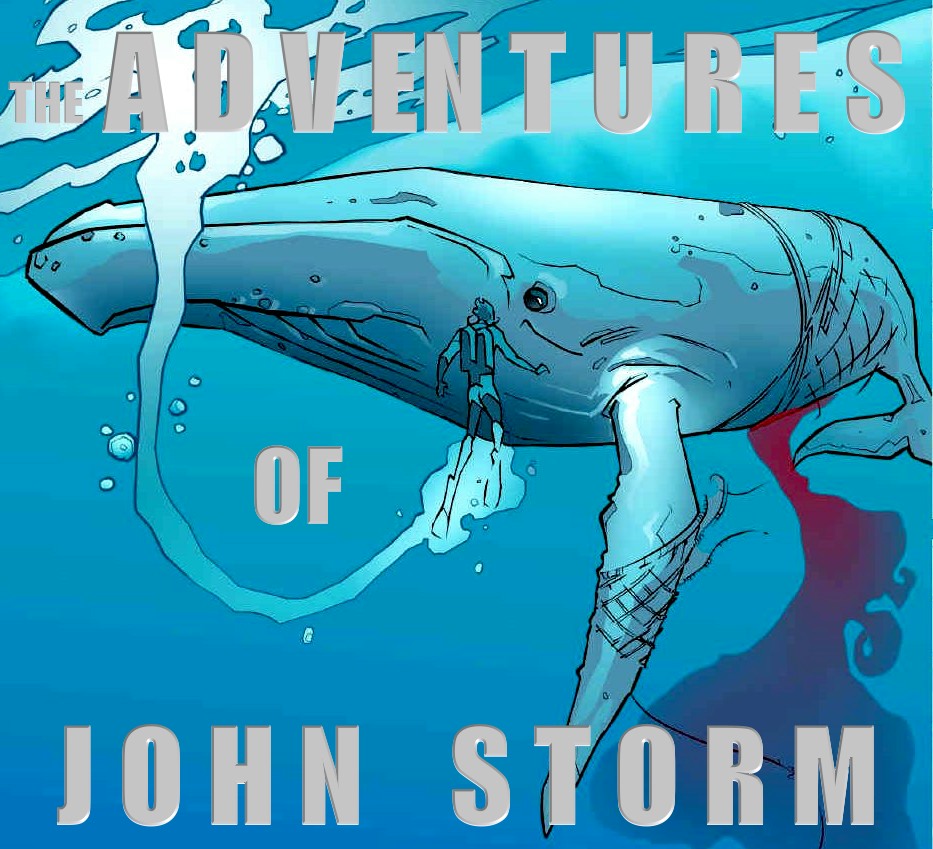
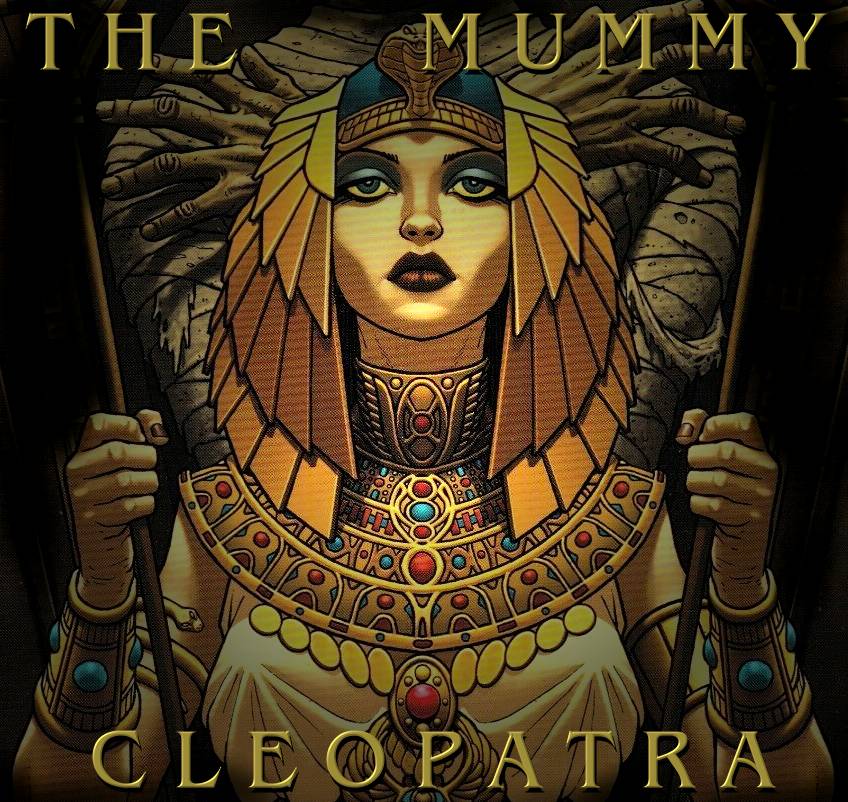
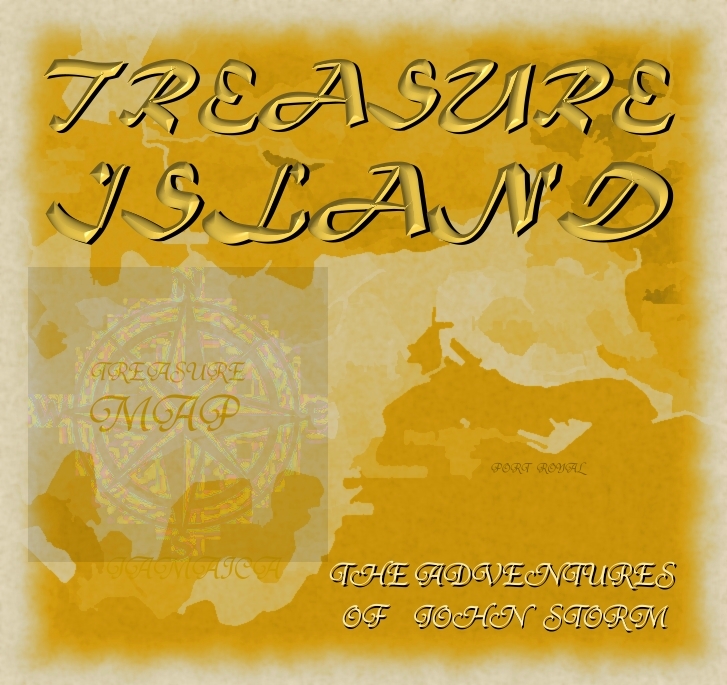
STUDIO/AGENTS: A draft script for
Kulo-Luna is available on request. Cleopatra The Mummy is currently under
development
|





